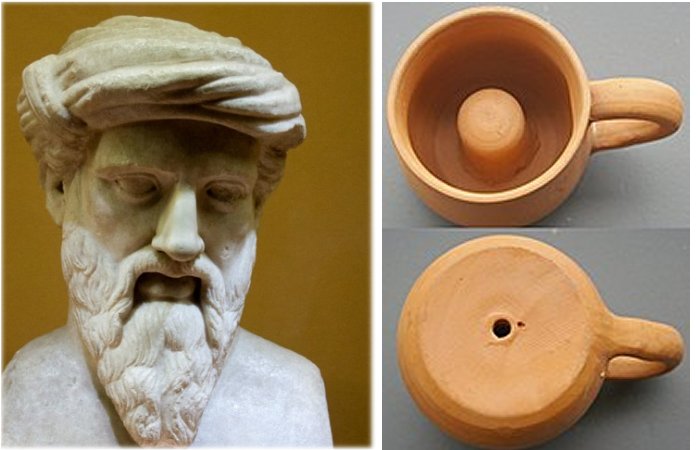Conny Waters – AncientPages.com – Some ancient scientists had great humor, and one of the world’s best practical jokes comes from Pythagoras, who invented a cup to punish greedy drinkers.
It’s a funny and clever ancient invention that has become so popular it can be bought today in many stores. The cup looks like just an ordinary cup, and it can fool anyone, even those who tried using it in modern times. Rest ᴀssured, it can undoubtedly be an excellent prank to play on someone.

Credit: Public Domain
Pythagoras of Samos (c. 570 – c. 495 BC) was an ancient Greek philosopher who transformed the ancient world and still inspired science, mathematics, philosophy, and the arts.
His famous mathematical model, the Pythagorean Theorem, which states that the square of the hypotenuse of a right triangle is equal to the sum of the squares on the other two sides, is still used today by different works in many real-life applications.
Pythagoras was knowledgeable, but he didn’t like those who drank too much wine.
It is often said Pythagoras created the Cup of Justice, but there is no conclusive evidence that links this vessel to the ancient Greek philosopher. Based on what is known, the cup appeared in the mid-6th Century B.C., so it’s ᴀssumed it was an invention of Pythagoras, but we don’t know this for certain.

Source: Nevit Dilmen/Wikimedia Commons
The cup’s innocent look doesn’t raise any suspicions, but the engineering behind it is a work of a mastermind. Once the unsuspecting drinker fills the cup past a specified level, the liquid mysteriously drains out. So how does it work?
The Cup of Justice has a small column in the middle fixed right over the cup’s stem. “The cup’s stem is hollow, leading to a small hole in the base of the cup.
Within the column is an open chamber. The column also features a small hole that allows the pᴀssage of liquid between the cup and the central column. When you fill the cup to just below the tip of the column, you’re able to drink without any issues. But, if you fill the cup beyond the column, then you’re going to run into some problems.
This is also how most flush toilets work.
The Greedy Cup was invented to remind people to drink sensibly, and it remains a popular practical joke. It happens often people drink too much alcohol while being at a party. Why not surprise those who consume too much with the Pythagorean cup?
Pythagoras was a very remarkable man. Did you know he and his followers didn’t eat beans?
Written by Conny Waters – AncientPages.com Staff Writer
Updated on January 13, 2023
Copyright © AncientPages.com All rights reserved. This material may not be published, broadcast, rewritten or redistributed in whole or part without the express written permission of AncientPages.com
Expand for references
- Saoirse Kerrigan – The Pythagorean Cup – The Cup That Spills Your Drink When You Get Too Greedy, Interesting Engineering
Skulls in the Stars – Physics demonstrations: the Pythagoras cup





